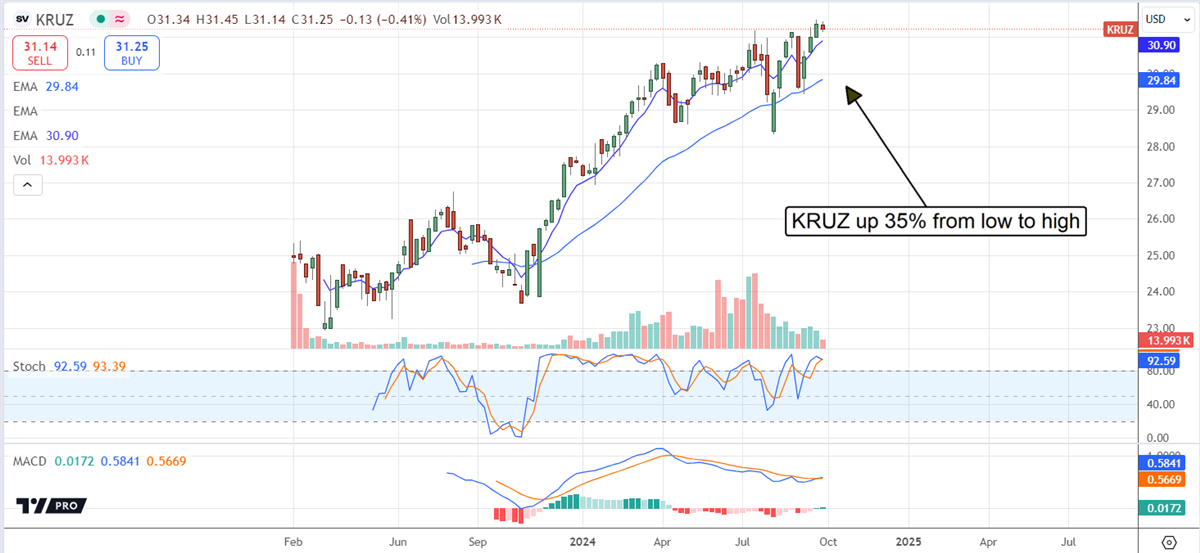- Tracking Congress members' trades is a good way to find some of the best investments: they tend to outperform the broad market.
- Investors can use two ETFs to get exposure to the group: one for Democrats and the other for Republicans.
- Aggregated analysts' data suggests both ETFs will hit new highs later this year.
Whether or not members of Congress have insider knowledge of a business is irrelevant: they certainly have insider knowledge of the government, legislation, and foreign affairs that will impact the stock market and the stocks they own. That’s why members of Congress so often outperform the broad market and why more investors than ever are following their trades. MarketBeat.com has tools to help investors track Congress's most recent and hottest trades, but other tools are available. Investors who want to use an ETF for broad exposure with less hassle may choose one of these aptly ticketed issues.
1. Democrats Lead the Charge in Technology-Focused Investments
The Subversive Unusual Whales Democratic ETF (NYSE:NANC) uses data aggregated by Unusual Whales to produce a portfolio based on the trading of Democratic members of Congress. The ticker symbol NANC is an homage to Nancy Pelosi, among the richest members of Congress with a net worth near $0.250 billion and a prolific trader. She and her fellow Democrats tend to invest heavily in technology stocks, with nine of the top ten portfolio holdings in that sector. The number one is NVIDIA (NASDAQ:NVDA), at more than 10%, followed by Microsoft (NASDAQ:MSFT), Alphabet (NASDAQ:GOOG), and Amazon (NASDAQ:AMZN). The single outlier is Disney, a leading consumer name providing deep value to investors in 2024.
Shares of NANC have been up 50% since the ETF's inception and are trending higher, aided by the AI revolution. The latest activity shows the market consolidating near record highs, supported by the long—and short-term EMAs and solid volume. Volume has subsided from the peaks set earlier this year but remains strong and will likely be reinvigorated following the Q3 reporting season.
NVIDIA alone is expected to grow its revenue by 75%, on top of the 200% gain posted last year, and will likely beat the consensus. Since before 2020, NVIDIA has outperformed 100% of the time regarding top- and bottom-line results. Coincidentally, the U.S. government is considering allowing NVIDIA to sell chips to Saudi Arabia so it can build its own AI models, which will be another multi-billion dollar market when opened.
MarketBeat aggregates the ratings of stocks within the Subversive Unusual Whales Democratic ETF. According to its data, the ETF is rated as a Moderate Buy based on nearly 1,100 analysts' reports. The reports cover 50 companies or more than 80% of the NANC portfolio, providing a relatively high conviction level. Trends in stocks like NVIDIA and Microsoft are positive, implying a nearly 10% upside for the ETF at the consensus and a high likelihood of an even higher high. 
2. Republicans Focus on Capital-Returning Stocks for Steady Gains
Republicans are invested in NVIDIA and tech to a lesser degree, with NVIDIA only 5% of the Subversive Unusual Whales Republican ETF (NYSE:KRUZ) compared to 12% for NANC. The result is underperformance in the share price, with KRUZ shares up only 25% from its inception and 35% from the low to the high.
However, Republicans' choices include capital-returning names in the financial, industrial, and energy sectors like JPMorgan (NYSE:JPM), Comfort Systems (NYSE:FIX), and National Fuel Gas (NYSE:NFG), so the total returns help to offset the difference. Capital returns include dividends, distribution growth, and share count-reducing repurchases, such as Comfort Systems' recently expanded one million share authorization.
The aggregated analyst rating for KRUZ is a Moderate Buy, based on over 925 reports. The group sees KRUZ advancing nearly 5% above the all-time high, leading to higher highs with revisions, but that trend may end soon. Names like JPMorgan have issued profit warnings for Q3 that have already capped gains.
However, the top fifty holdings represent only 67% of the portfolio, revealing a more diversified approach than the Democrats, so volatility is likely limited. The critical target for support is near $30. 
